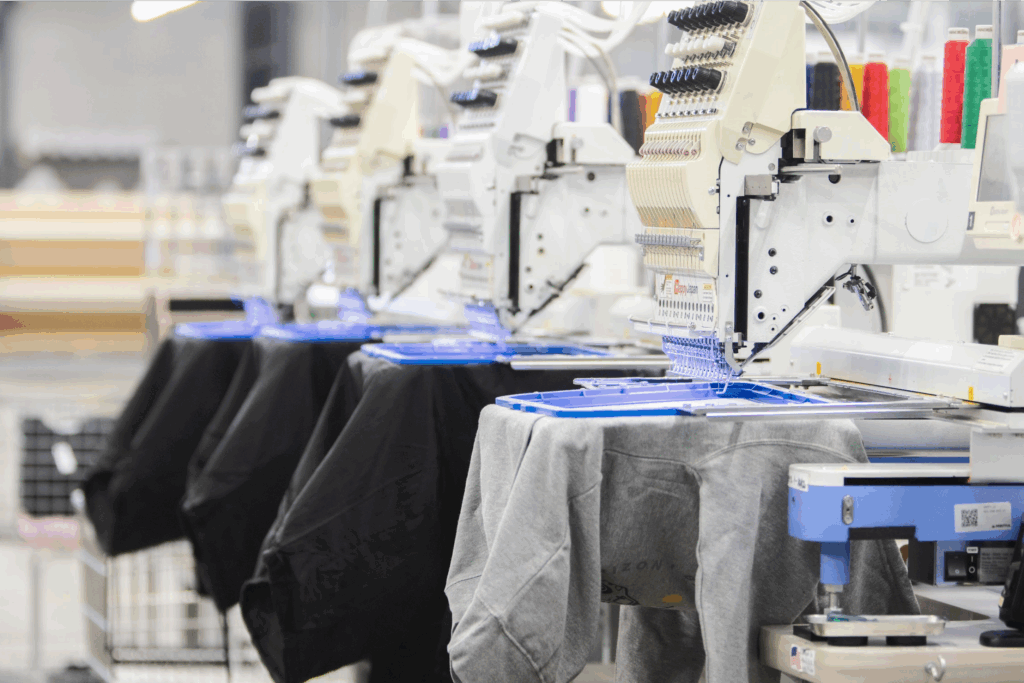Your business, your way – sell with Printify
With the global fashion eCommerce industry set to reach $1.6 trillion by 2030, now is the perfect time to start an online clothing store.
Whether you want to set up a niche online boutique or sell clothing to the masses, we’ll cover everything from selecting the right business model to finding the best digital marketing strategies.
By the end of this article, you’ll know how to start an online clothing store from home with zero inventory and no upfront investment.
This post may contain affiliate links, which means we may earn a commission if you make a purchase through those links. This comes at no additional cost to you.
Key takeaways
- Finding a specific market niche is important if you want your online clothing business to stand out and attract a loyal customer base.
- A strong fashion brand identity and solid business plan will help you connect with your target audience and gain authority in the industry.
- Choosing the right business model for your online store will impact your startup costs, inventory management, and overall risk.
- The Printify Pop-Up Store is an all-in-one solution for kickstarting your fashion brand without upfront costs or inventory management.
- Effective marketing strategies, including search engine optimization (SEO), social media, and email marketing help attract and retain customers.
How to open an online clothing store in 7 steps
Follow these seven steps to bring your clothing business idea to life.
1. Find your niche

The first step in starting a business without upfront costs is finding a market niche for your clothing company.
A niche is a specific market segment that appeals to people with common interests.
For example, your clothing niche could specialize in eco-friendly clothing for kids who love animals or plus-size athletic apparel for women who lift weights.
By focusing on a specific target market, you’ll tailor your products and marketing efforts to meet the unique needs of a particular group rather than trying to appeal to everyone.
- Consider your interests, research trending styles, find gaps in the market, and, most importantly, define your target audience.
- Use tools like Semrush and Google Trends to track consumer search trends, and analyze behavior reports and social media insights to better understand your potential customers.
Stay true to yourself, focus on authenticity, and avoid copying others’ work.
2. Choose a business name
Coming up with a proper business name is the next step in starting an online clothing store. Your name isn’t just a label – it’s the foundation of your brand’s identity and the first impression you make on your target market.
A great business name should:
- Reflect your brand’s essence.
- Be simple and memorable.
- Align with your fashion business’s values and style.
Think of original, easy-to-pronounce-and-spell names to make your online clothing store stand out and remain top-of-mind for online shoppers.
Pick something trendy yet evergreen that presents your brand’s identity and reflects its story, ethos, and future plans. Don’t over-focus on just one aspect of your store since it might not be relevant as your clothing brand evolves.
Check that your chosen name isn’t already taken or trademarked, as this could lead to legal complications.
3. Acquire a business license
In many cases, a business license isn’t just a formality – it’s a necessity. It legitimizes your store and sets your clothing company within legal guidelines.
Why do you need one?
- It’s a key step toward legal compliance. While it allows your online clothing business to operate legally, you must also ensure compliance with other local, state, and federal laws and regulations.
- It builds trust. A business license adds credibility to your business, making it more trustworthy in customers’ eyes.
- It’s beneficial for tax purposes. A license helps establish your business for tax filings, but proper accounting practices are also necessary to simplify tax compliance and separate business income from personal finances.
If you’re not located in the US, research your country’s legal requirements for opening an online clothing store to stay compliant.
Printify does not offer legal advice. Consult with certified professionals to ensure you’re compliant and informed about your location’s laws and regulations.
Any actions taken based on the information presented are at your own risk. Printify and its representatives are not liable for any losses, injuries, or damages arising from using the information provided.
It’s important to consult with appropriate professionals, such as legal, financial, or other experts, when making decisions that may have legal or financial implications.
By viewing this content, you acknowledge and agree to the terms of this disclaimer.
4. Choose your business model
Another decisive factor in the success of your online clothing store is choosing your business model, which will shape your operations, marketing strategies, and customer experience.
Here are a few popular business models to consider:
Print on Demand
Print on Demand (POD) is a popular choice for online business beginners due to its low startup costs and potential for solo entrepreneurs.
With this model, you create and list custom designs on white-label products through your online store. When a customer makes an order, your fulfillment partner handles printing and shipping to their address.
Benefits: Low or zero upfront costs and reduced risk are perfect for clothing businesses that want to sell merchandise with a limited budget.
Print on Demand offers huge flexibility in product offers. Change designs and switch your store catalog without wasting money on unsold inventory.
Dropshipping
Dropshipping is one of the most popular eCommerce business models, where merchants promote and sell pre-manufactured products that are shipped directly from suppliers to customers.
Benefits: Sellers can offer a wide range of products without adding custom designs or holding inventory, minimizing financial risk and operational overhead.
However, compared to other business models, it offers less control over product quality and shipping times.
Wholesale and warehousing
This business model involves purchasing products in bulk from manufacturers or wholesalers and storing them in your own warehouse (or other free space).
Benefits: Offers greater control over inventory, packaging, and shipping for more oversight on product quality and faster orders and delivery times.
However, warehousing requires a significant upfront investment and has the risk of unsold inventory, making it more suitable for established businesses with predictable capacity and demand.
5. Decide where to sell

Will you emphasize branding or break into the open market? Choosing where to sell your products should be high on your priority list.
Let’s compare the pros and cons of selling clothes on a marketplace vs using an eCommerce platform, along with Printify’s Pop-Up Store solution.
Marketplaces vs eCommerce platforms
Marketplaces like eBay and Etsy offer a large, active customer base, making it easier to establish your market presence.
However, these marketplaces are highly saturated and competitive, limiting your control and customization over your brand presence.
eCommerce platforms like Shopify, Wix, and BigCommerce give you more control over your brand and customer experience, but don’t come with a built-in market.
While they offer awesome customization options to make a store uniquely yours, they require more setup and come with a monthly subscription.
Printify Pop-Up Store
Printify offers a Pop-Up Store feature – an all-in-one solution for creating a personalized online store. It’s an excellent option for starting an online clothing business quickly and with no upfront costs.
The Pop-Up Store has limited customization compared to an eCommerce platform, but it’s the fastest way to get a store up and running for promotions.
Let’s compare all our options:
| Criteria | Marketplace (e.g., eBay, Walmart, Etsy) | eCommerce platform (e.g., Shopify, Wix, BigCommerce) | Printify Pop-Up Store |
|---|---|---|---|
| Customer base | Large audience of active online shoppers | No built-in customer base – self-driven traffic | No built-in customer base – self-driven traffic |
| Control over branding | Limited customization features | Complete control over store design and branding | Basic customization features like logo and social media links |
| Fees and costs | Listing and transaction fees (a percentage of each sale) | Monthly subscription fees and additional costs for apps and integrations | No upfront costs – only pay for fulfillment |
| Ease of setup | Easy to set up and start selling | Lengthier setup but offers more flexibility | Quick and easy setup |
| Traffic generation | Marketplaces drive traffic to listings, but SEO is on you | Fully responsible for marketing and SEO | Self-driven |
| Customer interaction | Direct interaction via buyer-seller messaging features | Direct interaction with customers via your platform | Printify handles customer support but offers limited direct interaction |
| Payment processing | Handled by the marketplace | Choose your own payment gateways | Handled by Printify |
| Shipping and Fulfillment | Varies by platform. Usually, the seller’s responsibility | Seller’s responsibility with options to integrate with shipping apps | Handled by Printify |
6. Design your clothing

The design phase is one of the most exciting parts of learning how to start an online clothing business from home (aside from watching the money roll in).
Here, you bring your vision to life by creating original artwork, experimenting with premade graphics and fonts, or collaborating with freelance designers.
So, what does it take to start a fashion business clothing line?
Start from scratch:
- Brainstorm ideas. Conceptualize your design ideas. Consider the theme, art style, subject matter, and message.
- Use design tools. Start with your preferred graphic design software and finalize your clothing products for free with the Printify Product Creator. It features a drag-and-drop editor, mockup preview, and other useful features like free graphics, text editor, and AI image generator.
- Experiment with colors and layouts. To create designs, try different color schemes, patterns, and layouts to get a feel for what best fits the print shape and material, while also reflecting you and your brand.
Use ready-made images and fonts:
- Find stock images and fonts. Try Adobe Stock, Shutterstock, and Unsplash for millions of high-quality images and fonts – some free, some paid.
- Hire a graphics designer. If you’re not confident in your design skills or just want a more polished look, consider hiring a professional graphic designer as part of your business plan.
Try out platforms like Fiverr or the Creative Market to connect with talented designers who can help bring your vision to life. - Try free resources. Visit sites like Pixabay, Pexels, or Google Fonts for a wide selection of images and fonts available for commercial use.
- Respect intellectual property. Make sure the images and fonts you use are royalty-free, or purchase the proper licenses to use them.
Using copyrighted material without permission can lead to legal issues and damage your reputation.
Always order product samples, especially if you choose POD, to check the product and print quality, guaranteeing they meet or even exceed your expectations.
7. Promote your online store
Your online clothing store is set up and your products are ready to go. Now, it’s time to let everyone know with a solid marketing strategy.
Promotion is the backbone of any online business, as even the best products can go unnoticed without effective campaigning. Let’s explore some exciting and proven ways to get the word out and drive traffic to your store.
Draw up a marketing strategy
Before promoting products on an eCommerce platform or marketplace, plan your content marketing strategy for long-term growth.
Identify your target market, set clear and measurable goals, and choose the best channels to reach potential customers.
To maximize your reach and impact, your strategy should include organic and paid marketing efforts, such as social media posts and Google ads.
Social media marketing
Popular social media platforms like Instagram, Facebook, and TikTok are goldmines for organically promoting any online boutique or creative business.
Take advantage of platform-specific features like Instagram Stories, the Facebook Marketplace, and TikTok Shop to promote and sell your products.
Post regularly, engage with your followers, and use relevant hashtags to increase your visibility. Build trust and loyalty, and the sales will follow.
SEO
Optimize your website to rank higher in search results on popular search engines like Google. Relevant keywords in your landing pages, product listings, content, and meta tags can influence search results in your favor.
SEO helps potential customers find your store when searching for related products, driving organic traffic to your page and reducing ad expenses.
Enhance your SEO strategy with content marketing by sharing helpful blog posts, product newsletters, fashion insights, and style guides.
Join our SEO Masterclass to become an expert.
Email marketing
Create an email list and send newsletters with updates, promotions, and personalized recommendations to keep your subscribers engaged.
Automated email marketing campaigns like welcome emails and cart abandonment reminders can also increase sales and customer retention.
Paid advertising
Running paid ads with Google Ads or using social media advertising on platforms like Facebook and Instagram can quickly increase store visibility.
Target your ads to reach your ideal customers, and experiment with different ad formats, such as search and display ads, to see what works best for your eCommerce website or marketplace.
Affiliate marketing and partnerships
Joining affiliate programs or creating your own lets you drive traffic to your store and accelerate sales through trusted recommendations.
Partner with other businesses and social media influencers who promote your products in exchange for a commission on sales they generate on your behalf.
Become a Printify Affiliate to receive a 5% commission from each sale your referrals make in their first 12 months.
Open an online clothing store with Printify
Tips for starting a successful online clothing store
Starting a successful online clothing store requires persistence, adaptability, and an understanding of your paying customers.
So, what can a small business owner do to start an online clothing business from home?
Create a strong brand identity
Your brand identity is more than just a logo – it’s the complete package of your design style, brand colors, tone of communication, messaging, and values.
Build a brand identity that resonates with your audience, sets you apart from competitors, and forms the heart of your online boutique.
Keep your branding consistent across all channels, from your eCommerce website to your social media profiles.
Learn from other eCommerce stores
One of the best ways to learn is by looking at other successful online clothing stores.
See what makes them stand out by answering the following questions:
- How are their products presented?
- What methods do they use to engage with shoppers?
- How do they handle customer service?
- What is their approach to customer service?
- Do they offer free shipping?
- Are their sites optimized for mobile devices?
Learning from established eCommerce stores can offer valuable insights and inspiration for your own online boutique, especially those in your niche.
Free shipping makes happy customers
Offering free shipping can be a game-changer for your business. It can significantly reduce cart abandonment and attract potential customers.
By incorporating shipping costs into your product prices, you can offer free shipping without lowering your profit margin.
Consider offering free products with purchases to further entice and satisfy your shoppers.
Take advantage of seasonality
Seasonal trends heavily influence clothing sales. Capitalize on shifts in consumer demand by adjusting your product offerings and marketing strategies.
For example, promote cozy winter wear as temperatures drop or highlight swimwear as summer approaches.
Use our marketing calendar to strategically plan promotions around important seasonal shifts and significant retail events.
Check out our list of 31 Best-selling products in 2025 for inspiration.
Be active on social media
Regularly post on platforms where your target audience spends time – share behind-the-scenes content, new arrivals, testimonials, and engaging visuals.
Social media marketing goes beyond promoting products – it’s about nurturing a community of loyal, repeat customers who feel connected to your brand.
Use social media to grow your business, foster relationships, gather feedback and maintain a vibrant presence in your industry.
Gain customer loyalty
The best customer is a loyal customer, especially for a fashion brand. Encourage repeat purchases with customer-focused incentives like loyalty points, store credit, and referral bonuses.
To build a loyal and authentic client base, provide excellent customer service, respond promptly to questions, and show that you value customer feedback.
How to start your own online clothing store with no inventory
With Printify, you don’t need a clothing manufacturer like in brick-and-mortar stores.
Whether you work with large or small businesses, follow these simple steps to get started:
Create a Printify account
Sign up for a Printify account and start your online business without fees or subscription costs.
Design your products
Printify offers over 1,300 customizable products. Use our Product Creator to design and personalize a wide range of items to fit your brand’s style. Play around with different fonts and designs to make clothing customers love.
Adjust, preview, and save once you’re happy with your design.
Connect and launch your store
Link your Printify account to a popular eCommerce platform or marketplace like Shopify, Walmart, or Etsy. Our eCommerce integrations sync your products, manage inventory, and fulfill orders automatically.
Follow the step-by-step instructions to connect your store, and you’ll be ready to sell clothes online in no time.
Publish and start selling online
Once your eCommerce website is connected and your products are set up, you’re ready to go live.
Double-check that product details, images, and prices are accurate. Check that your website is user-friendly, with easy navigation, a smooth checkout process, and secure online payments.
If you want to expand your reach in the apparel market and cater to customers who prefer in-person shopping experiences, place bulk orders to sell your clothing in a physical store.
Product ideas for your online clothing line
Succeeding in the fashion industry with your online store means blending trendsetting designs with marketable products.
Here’s a look at some of the most popular items to add to your clothing line, along with inspiring design ideas to make your brand shine.
T-shirts
T-shirts are one of the best-selling garments in the world, raking in billions of dollars per year. Almost everyone has one in their closet, making them a great start for any clothing business.
To resonate with diverse customer groups, think beyond the basics, like eco-friendly materials, vintage-inspired graphics, minimalism, or retro pop culture.
Check out the story of NerdyKeppie and see how Spider B. Perry transformed their passion for t-shirt designs into a thriving online store.
Hoodies
Hoodies are an excellent addition to your online store, combining comfort with style. Introduce oversized or cropped hoodies with bold typography, abstract art, or street art-inspired designs.
Take a look at Afro Unicorn. Its founder, April Showers, is the first black woman to own a licensed character brand, selling her hoodies and more in major retailers across the US.
Sweatshirts
Sweatshirts are perfect for layering and appeal to customers who prefer a relaxed, casual look. From abstract colors and high-resolution photos to graphic prints, sweatshirts can be a great hit in your online boutique.
Whether lounging at home or making a fashion statement outside, a well-customized sweatshirt adds flair to any wardrobe.
Skirts
Skirts offer endless possibilities for customization and style.
From breezy maxi skirts perfect for summer days to chic midi skirts that transition effortlessly from work to evening outings, the options are endless.
Add flair with unique patterns, playful prints, or sophisticated solid colors to make your skirts stand out in any closet.
Dresses
A fashion store without dresses is like a garden without flowers.
Pack your store with diverse styles, like relaxed sundresses, elegant evening gowns, and versatile day-to-night options.
Vibrant prints and flattering cuts can transform your dresses into must-have pieces that attract a wide range of customers.
Shoes
The finishing touch can make or break any outfit. Expand your collection by adding shoes in different styles, including comfy sneakers, stylish boots, and elegant heels.
Stand out with one-of-a-kind custom options in bold color combos, trendy patterns, and personalized touches that make each pair of shoes truly unique.
With diverse footwear choices, make your store the ultimate go-to for footwear enthusiasts.
Sportswear
With the growing health and fitness trend, workout sets have become increasingly popular, as has going for a jog outside.
Offer high-quality, functional and stylish sportswear to satisfy fitness enthusiasts and appeal to those seeking comfort wear.
Accessories
Accessories like custom hats and socks can easily complement your main product line and attract impulse buyers.
Design custom hats and socks with unique all-over-print patterns, logos, or color schemes that reflect your brand’s unique identity.
Include various accessories in your inventory to enhance the appeal of your online boutique and increase sales.
FAQ: How to start selling clothes online
Absolutely. Start an online store with no money by partnering with print-on-demand platforms like Printify.
Create designs and a solid business plan, and our Print Providers will handle the rest – printing and shipping products directly to your customers.
Although costs can vary greatly based on factors like monthly subscriptions on eCommerce platforms and costs of running ad campaigns, starting your own clothing line online can also be surprisingly affordable.
With the print-on-demand business model, it’s possible to sell products online with zero upfront costs – all orders are fulfilled on demand.
This minimizes financial risk while letting you offer a large selection of customizable products in your clothing store.
Yes, starting a clothing business online can be profitable. Many online clothing brands thrive through digital content marketing and strategic partnerships that drive sales and build a loyal customer base.
Choosing the right niche, offering unique products, and effectively managing pricing strategies can significantly impact your store’s profitability.
Advertise your clothing store with SEO, social media marketing, influencer partnerships, email campaigns, and paid advertising.
Optimizing your website with relevant keywords, creating engaging content, and ensuring it’s mobile-friendly can drive organic traffic.
Use high-quality images that show your products from multiple angles. Include close-ups of fabric and details to give customers a clear idea of what they’re buying.
Use models or mannequins to showcase fit and style, and consider lifestyle photos to show your clothes in everyday settings.
Additionally, write detailed product descriptions highlighting key features, sizing information, and care instructions.
Summary
Now you know how to start a clothing brand online, from choosing the right niche and business model to creating unique designs and employing savvy marketing strategies.
Roll up your sleeves, embrace our insights, and start your journey toward success with Printify.












